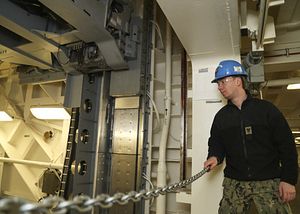The USS Gerald R. Ford (CVN-78) has accepted its second advanced weapons elevator (AWE) nearly one month following the acceptance of its first. The USS Gerald R. Ford, commissioned in July 2017, is undergoing a post-shakedown availability (PSA) in Newport News, Virginia. At the time of the carrier’s commissioning none of its 11 weapons elevators were fully operational.
AWEs carry bombs and missiles quickly to carrier’s flight deck to be loaded onto fighter jets. It is a crucial component in guaranteeing fast aircraft sortie rates. According to the AWE’s designer, Cincinnati-based Federal Equipment Company, the Ford’s systems are 150 percent faster than elevators on the Nimitz-class and also have 240 percent more capacity. The carrier has three upper-stage elevators and seven lower-stage elevators to move ordnance.
As other new technologies and subsystems installed aboard the Ford, the AWE was plagued by a host of technical problems. According to a June 2017 Government Accountability Office report, the AWEs “continue to have issues with reliability, which will affect their ability to support aircraft operations.” Notably, Secretary of the Navy Richard V. Spencer promised U.S. President Trump that all 11 AWE would be working by the end of PSA, scheduled to occur in July, otherwise he would resign.
According to a recent U.S. Navy statement, AWE Upper Stage Number 3 was turned over to the Ford on February 14, following testing and certification by engineers at Huntington Ingalls Industries-Newport News Shipbuilding (NNS). Acceptance of the elevator was reportedly sped up by merging test programs between NNS and the Naval Surface Warfare Center (NSWC), “which removed redundant steps and moved certification up by 10 days,” according to the Navy. “The team has identified other areas where redundancy can be removed to make the acceptance timelines more efficient.”
Remaining AWE deliveries are slated to take place in the coming months.
“The combined efforts of NNS and NSWC to remove inefficiencies in the test program highlights how well our teams are working together,” the commanding officer of the Ford, Captain J.J. Cummings said. “These are the most technologically unique elevators in the world, and we are going to need to find innovative methods to get the remaining nine elevators delivered this year.”
“Our Weapons Department Sailors are hungry to operate these elevators so we can start developing procedures to maximize the flow of ordnance from our magazines to the flight deck,” he added.
The USS Gerald R. Ford is the most expensive warship in U.S. Navy history, with total procurement cost amounting to approximately $13 billion. The U.S. Navy signed a $14.9 billion contract with (HII-NNS for the next two Gerald R. Ford-class aircraft carriers this February. By buying two flattops concurrently under one contract, the service expects to save over $4 billion.































